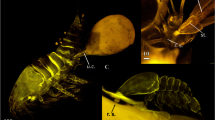Abstract
The ultrastructure of the cuticle of adult and larval Priapulus caudatus and Halicryptus spinulosus is investigated and new features of cuticle formation during moulting are described. For the localization of chitin by TEM wheat germ agglutinin coupled to colloidal gold was used as a marker. Proteinaceous layers of the cuticle are revealed by digestion with pronase. The cuticle of larval and adult specimens of both species consists of three main layers: the outer, very thin, electron-dense epicuticle, the electron-dense exocuticle and the fibrillar, electron-lucent endocuticle. Depending on the body region, the exocuticle comprises two or three sublayers. The endocuticle can be subdivided into two sublayers as well. In strengthened parts such as the teeth, the endocuticle becomes sclerotized and appears electron-dense. Only all endocuticular layers show an intense labelling with wheat germ agglutinin-gold conjugates in all investigated specimens. Additional weak labelling is observed in the exocuticle III layer of the larval lorica of P. caudatus. All other cuticular layers remain unlabelled. Chitinase dissolves the unsclerotized endocuticular layers almost completely, but also exocuticle II and partly the loricate exocuticle III. The epicuticle, the homogeneous exocuticle I and the sclerotized endocuticle are not affected by chitinase. The labelling is completely prevented in all layers after incubation with chitinase. Pronase dissolves all exocuticular layers, but not evenly. The presumably sclerotized regions of exocuticle I are not affected as well as the complete epicuticle and the endocuticle. All cuticular features of the Priapulida are compared with the cuticle of each high-ranked taxon within the Nemathelminthes with special regard to the occurrence of chitin. Based on this out-group comparison it can be concluded that: (1) a two-layered cuticle with a trilaminate epicuticle and a proteinaceous basal layer represents an autapomorphic feature of the Nemathelminthes, (2) the stem species of the Cycloneuralia have already evolved an additional basal chitinous layer, (3) such a three-layered cuticle is maintained as a plesiomophy in the ground pattern of the Scalidophora and (4) in the Nematoida, the chitinous basal layer is replaced by a collagenous one at least in the adults; the synthesis of chitin is restricted to early developmental phases or the pharyngeal cuticle.
Similar content being viewed by others
Author information
Authors and Affiliations
Additional information
Accepted: 12 March 1998
Rights and permissions
About this article
Cite this article
Lemburg, C. Electron microscopical localization of chitin in the cuticle of Halicryptus spinulosus and Priapulus caudatus (Priapulida) using gold-labelled wheat germ agglutinin: phylogenetic implications for the evolution of the cuticle within the Nemathelminthes. Zoomorphology 118, 137–158 (1998). https://doi.org/10.1007/s004350050064
Issue Date:
DOI: https://doi.org/10.1007/s004350050064




